Grid Connection Studies for Large-Scale Offshore Wind Farms Considering High Penetration of Regional Renewables
Abstract
:1. Introduction
2. Materials and Methods
2.1. Steady-State Analysis
2.1.1. Assessment of System Strength Reflecting Interaction of Offshore Wind Farms and the Other IBRs
2.1.2. Procedure for Analyzing Fault Current Considering Fault Current Contribution from Offshore Wind Farms and the Other IBRs
2.2. Case Studies
2.2.1. Case Studies in the Southwest Area of the KEPCO System
2.2.2. Modeling of Large-Scale Wind Farms Connected via an Onshore Collector Bus
3. Results and Discussion
3.1. Assessment of System Strength
3.2. Analysis of Fault Current
4. Conclusions
Author Contributions
Funding
Institutional Review Board Statement
Informed Consent Statement
Data Availability Statement
Acknowledgments
Conflicts of Interest
Appendix A
| Bus | Short-Circuit Capacity (MVA) | IBR Generation (MW) |
|---|---|---|
| Sinjeongeup3 | 18,619 | 1680 (Offshore wind farm #1) |
| Sinjangsung3 | 15,831 | 2450 (Offshore wind farm #2) |
| Sinhwasoon3 | 12,392 | 2100 (Offshore wind farm #3) |
| Singangjin3 | 11,159 | 2940 (Offshore wind farm #4) |
| Anjwa1 | 3245 | 495 |
| UiWindSY1 | 3188 | 380 |
| Yeonggwang1 | 2498 | 263 |
| Wando1 | 2530 | 231 |
| Woonnam1 | 3324 | 251 |
| NagwolWindSY1 | 2487 | 149 |
| BigumSolarSY1 | 3556 | 115 |
| Gochang1 | 3431 | 81 |
| Haenam1 | 4111 | 83 |
| Daebul1 | 4601 | 65 |
| MuanSolarSY1 | 3326 | 40 |
| Eomda1 | 3723 | 38 |
| Jindo1 | 3133 | 28 |
| Hwawon1 | 3853 | 31 |
| Samho1 | 4061 | 33 |
| Naju1 | 7577 | 51 |
| Eupdong1 | 3235 | 11 |
| Bukhang1 | 3586 | 5 |
References
- Milano, F.; Dörfler, F.; Hug, G.; Hill, D.; Verbic, G. Foundations and Challenges of Low-Inertia Systems. In Proceedings of the Power Systems Computation Conference (PSCC), Dublin, Ireland, 11–15 June 2018; pp. 1–25. [Google Scholar]
- Elliott, D.; Bell, K.R.; Finney, S.J.; Adapa, R.; Brozio, C.; Yu, J.; Hussain, K. A Comparison of AC and HVDC Options for the Connection of Offshore Wind Generation in Great Britain. IEEE Trans. Power Deliv. 2016, 31, 798–809. [Google Scholar] [CrossRef] [Green Version]
- Chang, Z.; Wang, X.; Wei, Z.; Lu, G.; Lu, J.; Huang, Y.; Gao, K.; Li, T.; Tang, J. Analysis of influence of large-scale wind farm grid connection on system short-circuit current. In Proceedings of the 2019 4th IEEE Workshop on the Electronic Grid (eGRID), Xiamen, China, 11–14 November 2019; pp. 1–6. [Google Scholar] [CrossRef]
- Du, W.; Dong, W.; Wang, H.; Cao, J. Dynamic Aggregation of Same Wind Turbine Generators in Parallel Connection for Studying Oscillation Stability of a Wind Farm. IEEE Trans. Power Syst. 2019, 34, 4694–4705. [Google Scholar] [CrossRef]
- Melis, U.; Şener, Z. Suitable map analysis for wind energy projects using remote sensing and GIS: A case study in Turkey. Environ. Monit. Assess. 2019, 191, 459. [Google Scholar]
- Kundur, P. Power System Stability and Control; McGraw-Hill Inc.: New York, NY, USA, 1994; pp. 105–127. [Google Scholar]
- IEEE Guide for Planning DC Links Terminating at AC Locations Having Low Short-Circuit Capacities; IEEE Std 1204-1997; IEEE SA Standards Board: New York, NY, USA, 1997; pp. 1–216. [CrossRef]
- Huang, S.H.; Schmall, J.; Conto, J.; Adams, J.; Zhang, Y.; Carter, C. Voltage control challenges on weak grids with high penetration of wind generation: ERCOT experience. In Proceedings of the 2012 IEEE Power and Energy Society General Meeting, San Diego, CA, USA, 22–26 July 2012; pp. 1–7. [Google Scholar] [CrossRef]
- Zhang, Y.; Huang, S.H.F.; Schmall, J.; Conto, J.; Billo, J.; Rehman, E. Evaluating system strength for large-scale wind plant integration. In Proceedings of the 2014 IEEE PES General Meeting|Conference & Exposition, National Harbor, MD, USA, 27–31 July 2014; pp. 1–5. [Google Scholar] [CrossRef]
- Huang, F. Experience with WTG weak system interactions on the ERCOT system. In Proceedings of the 2015 IEEE Power & Energy Society General Meeting, Denver, CO, USA, 26–30 July 2015; pp. 16–30. [Google Scholar]
- Choi, N.; Lee, B.; Kim, D.; Nam, S. Interaction boundary determination of renewable energy sources to estimate system strength using the power flow tracing strategy. Sustainability 2021, 13, 1569. [Google Scholar] [CrossRef]
- Baran, M.E.; El-Markaby, I. Fault analysis on distribution feeders with distributed generators. IEEE Trans. Power Syst. 2005, 20, 1757–1764. [Google Scholar] [CrossRef]
- Simic, N.; Strezoski, L.; Dumnic, B. Short-circuit analysis of DER-based microgrids in connected and islanded modes of operation. Energies 2021, 14, 6372. [Google Scholar] [CrossRef]
- Chu, Z.; Teng, F. Short-circuit current constrained UC in High IBG-Penetrated Power Systems. IEEE Trans. Power Syst. 2021, 36, 3776–3785. [Google Scholar] [CrossRef]
- Choi, N.; Park, B.; Cho, H.; Lee, B. Impact of momentary cessation voltage level in inverter-based resources on Increasing the short-circuit current. Sustainability 2019, 11, 1153. [Google Scholar] [CrossRef] [Green Version]
- Barker, P.; DeMello, R. Determining the impact of DG on power systems, radial distribution. In Proceedings of the 2000 Power Engineering Society Summer Meeting (Cat. No.00CH37134), Seattle, WA, USA, 16–20 July 2000; Volume 3, pp. 1645–1656. [Google Scholar]
- Keller, J.; Kroposki, B.D. Understanding Fault Characteristics of Inverter-Based Distributed Energy Resources. 2010. Available online: http://research.iaun.ac.ir/pd/bahador.fani/pdfs/UploadFile_9423.pdf (accessed on 16 November 2018).
- Kim, D.; Cho, H.; Park, B.; Lee, B. Evaluating influence of inverter-based resources on system strength considering inverter interaction level. Sustainability 2020, 12, 3469. [Google Scholar] [CrossRef] [Green Version]
- Ministry of Trade, Industry & Energy(MOTIE) of the Republic of Korea. Offshore Wind Power Generation Plan to Coexist with Residents and to Coexist with the Fishery Industry. 19 July 2020. Available online: http://www.motie.go.kr/motie/gov3.0/gov_openinfo/sajun/bbs/bbsView.do?bbs_seq_n=163153&bbs_cd_n=81 (accessed on 1 December 2021).
- Bialek, J. Tracing the flow of electricity. IEE Proc.-Gener. Transm. Distrib. 1996, 143, 313–320. [Google Scholar] [CrossRef] [Green Version]
- Park, S.; Jin, H.; Kim, H.; Cho, Y. A Study on Future System Construction Using WSCR Strengthness Index Based on Python. 2018. Available online: http://www.dbpia.co.kr/journal/articleDetail?nodeId=NODE07511879 (accessed on 1 August 2018).
- Liu, S.; Bi, T.; Liu, Y. Theoretical analysis on the short-circuit current of inverter-interfaced renewable energy generators with fault-ride-through capability. Sustainability 2018, 10, 44. [Google Scholar] [CrossRef] [Green Version]
- Kennedy, J.; Ciufo, P.; Agalgaonkar, A. Fault approximation tool for grid-connected inverter-interfaced distributed generators. In Proceedings of the 2014 Australasian Universities Power Engineering Conference (AUPEC), Perth, Australia, 28 September–1 October 2014. [Google Scholar] [CrossRef] [Green Version]
- Brucoli, M.; Green, T.C.; McDonald, J.D.F. Modelling and analysis of fault behaviour of inverter microgrids to aid future fault detection. In Proceedings of the 2007 IEEE International Conference on System of Systems Engineering, San Antonio, TX, USA, 16–18 April 2007; pp. 1–6. [Google Scholar] [CrossRef]
- Boutsika, T.N.; Papathanassiou, S.A. Short-circuit calculations in networks with distributed generation. Electr. Power Syst. Res. 2008, 78, 1181–1191. [Google Scholar] [CrossRef]
- El-Naggar, A.; Erlich, I. Fault current contribution analysis of doubly fed induction generator-based wind turbines. IEEE Trans. Energy Convers. 2015, 30, 874–882. [Google Scholar] [CrossRef]
- Walling, R.; Harley, R.; Miller, D.; Henneberg, G.; Barsch, J.; Bartok, J.; Benmouyal, G.; Bolado, O.; Boysen, B.; Brahms, S.; et al. Fault current contributions from wind plants. In Proceedings of the 2015 68th Annual Conference for Protective Relay Engineers, College Station, TX, USA, 30 March–2 April 2015; pp. 137–227. [Google Scholar] [CrossRef]
- Ministry of Trade, Industry & Energy (MOTIE) of the Republic of Korea. The 9th Basic Plan for Long-term Electricity Supply and Demand. 28 December 2020. Available online: https://www.motie.go.kr/motie/py/td/tdtotal/bbs/bbsView.do?bbs_cd_n=72&bbs_seq_n=210325 (accessed on 1 December 2021).

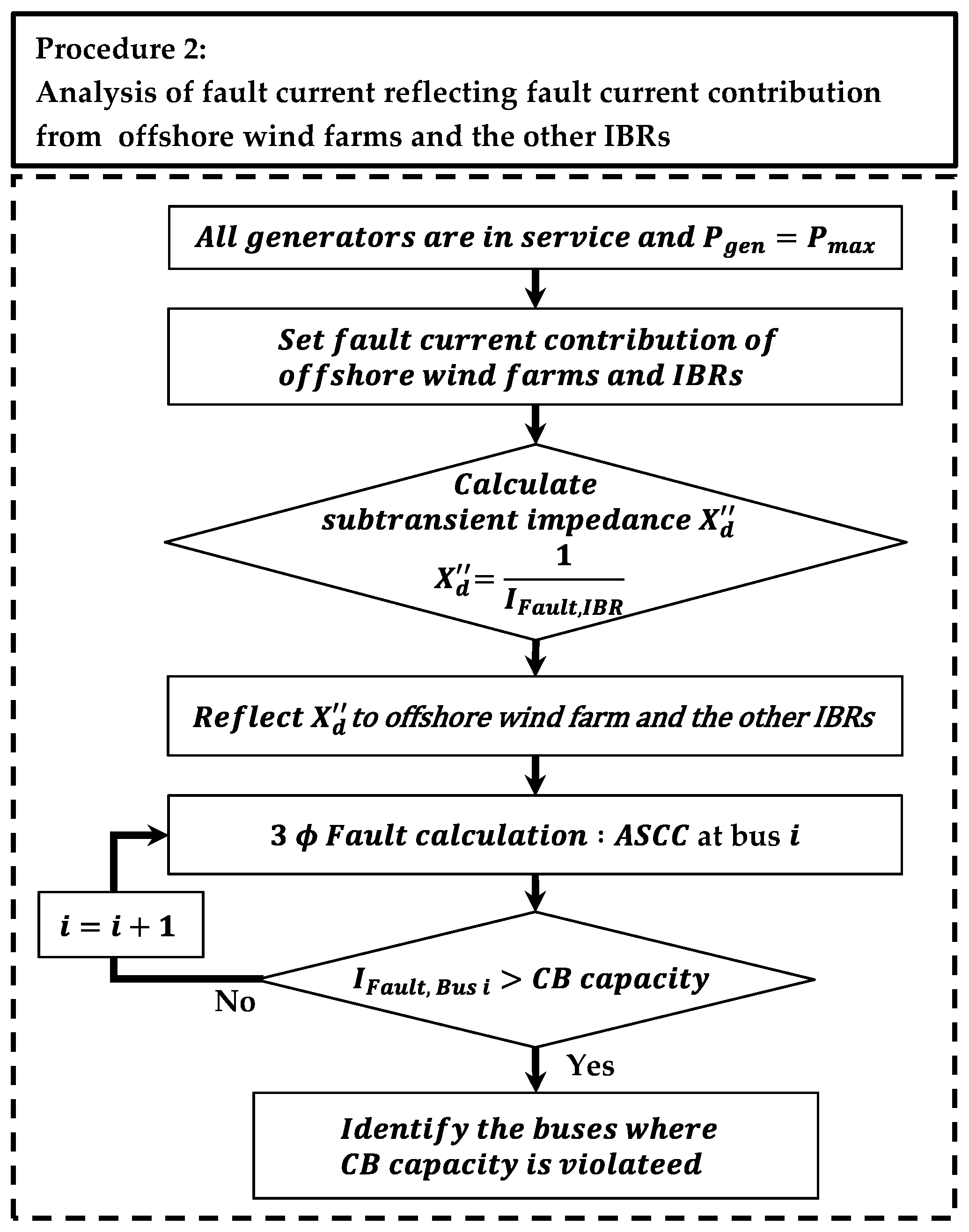
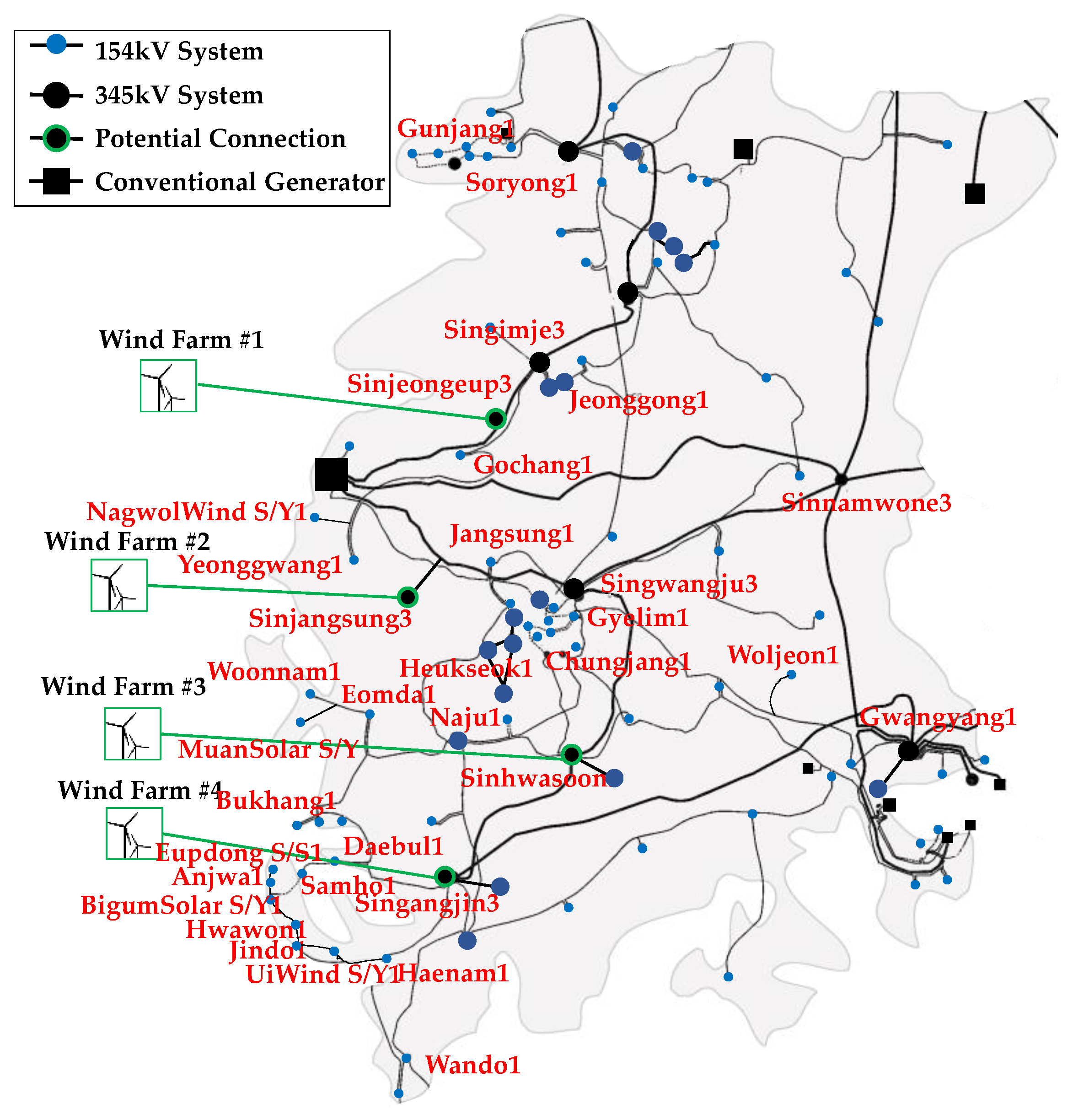

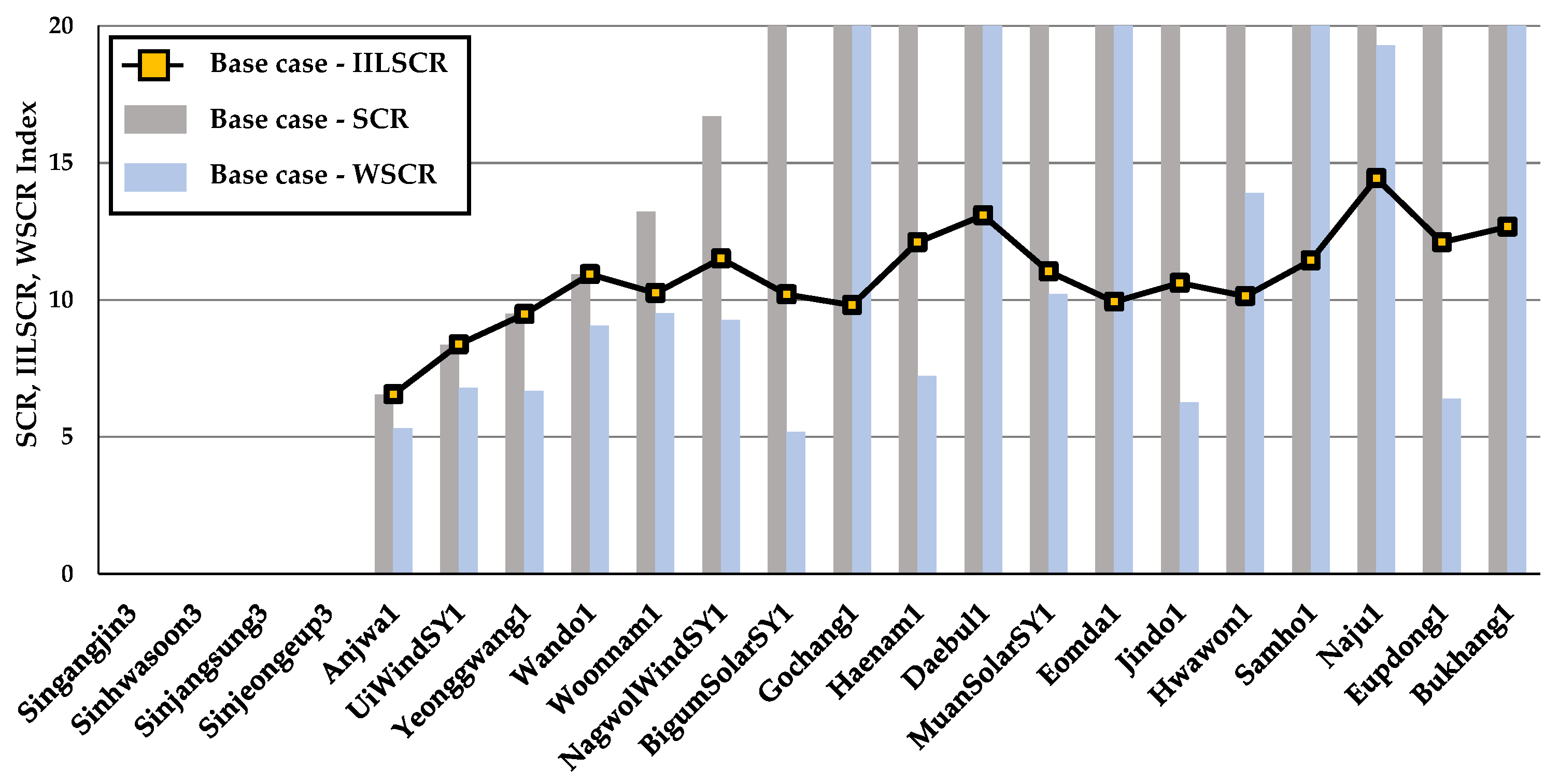
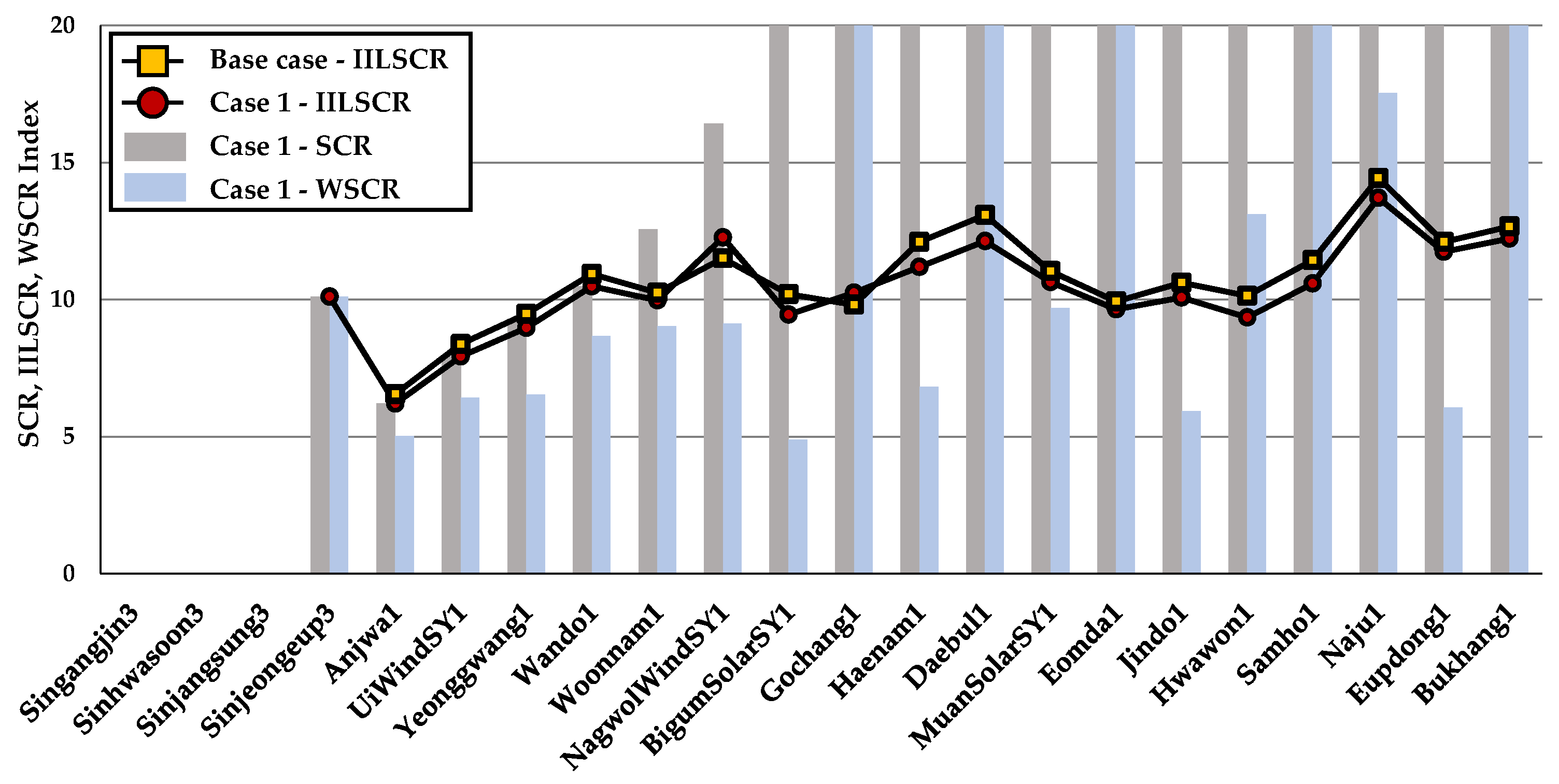

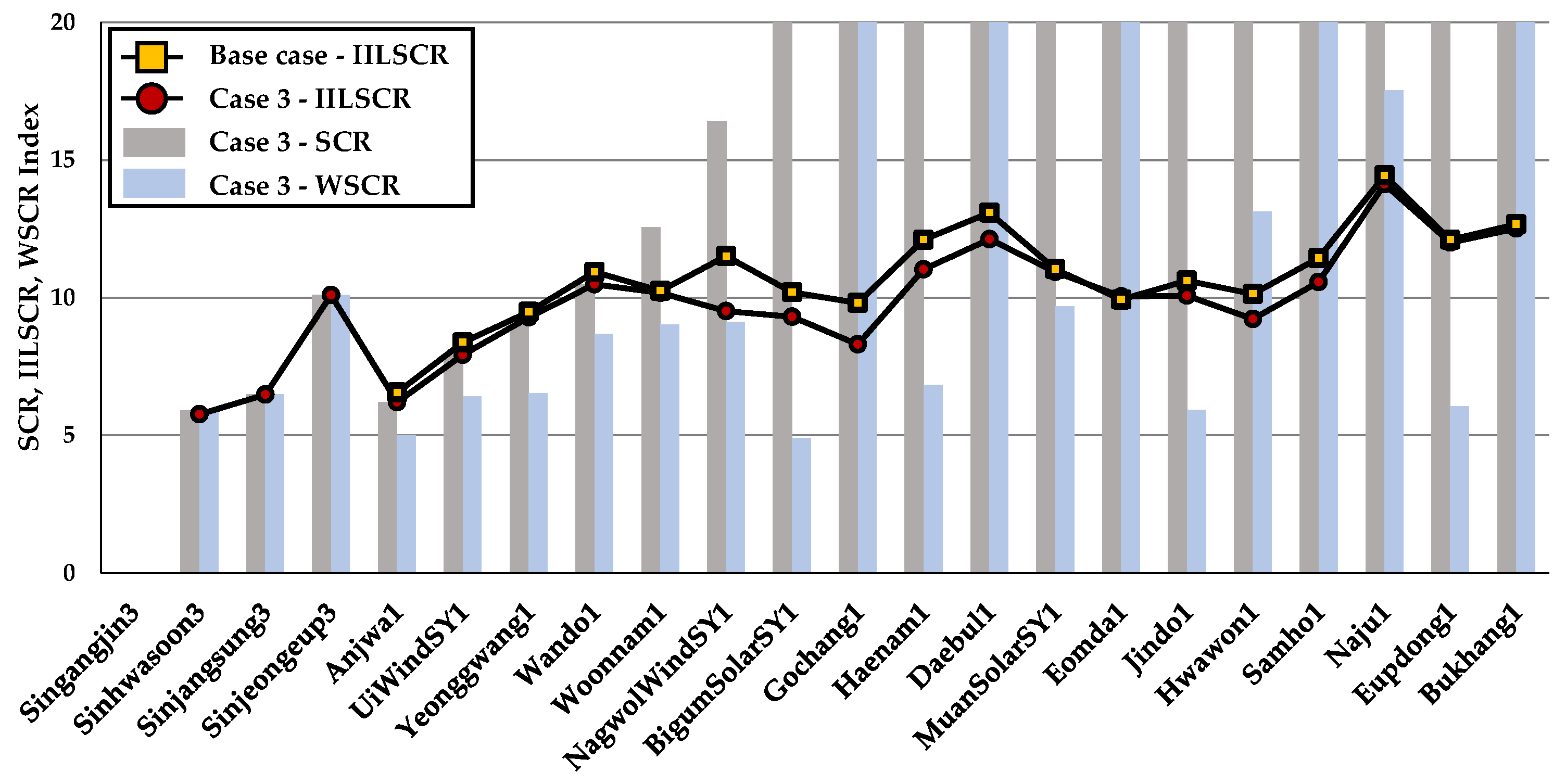
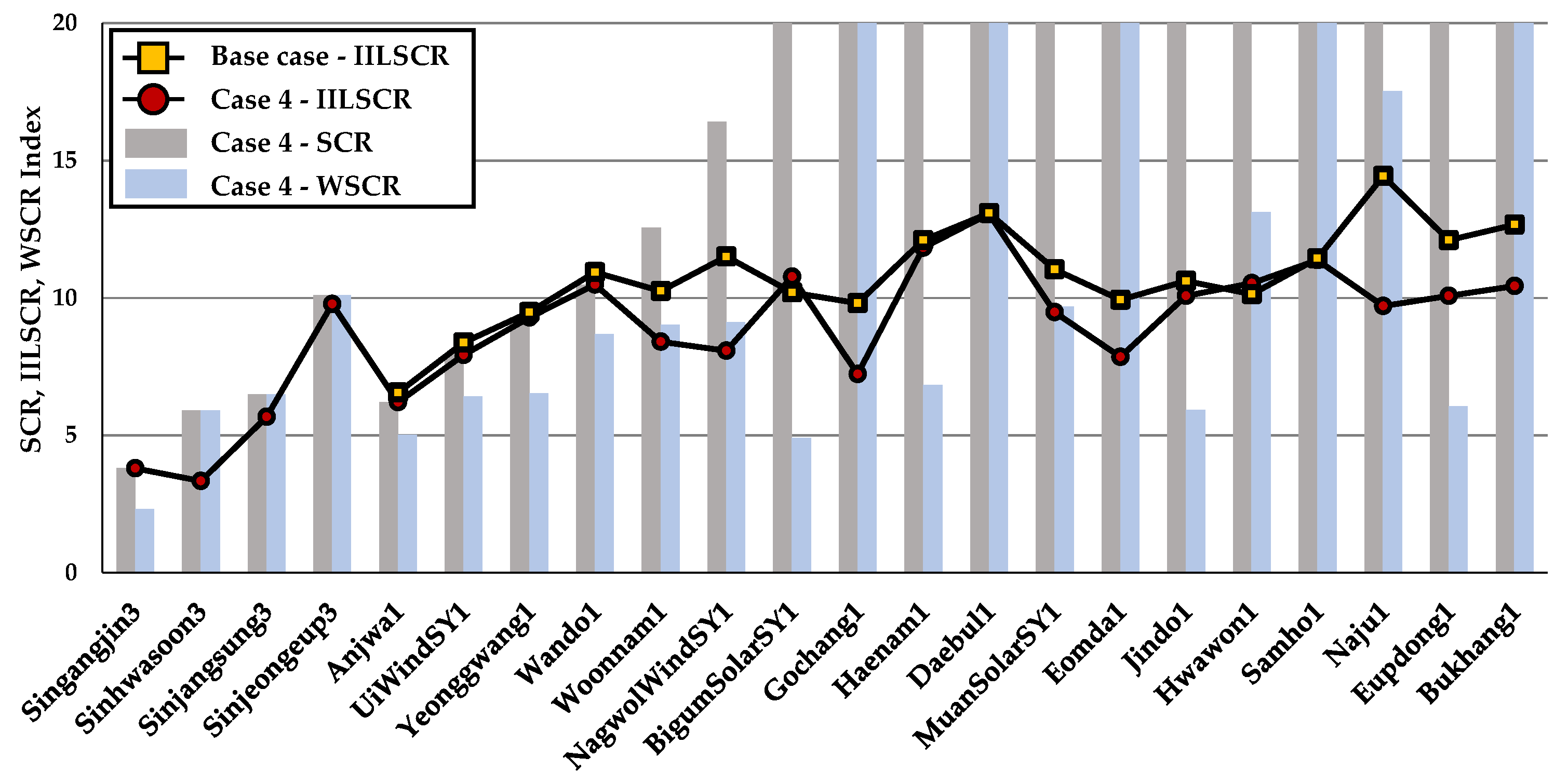
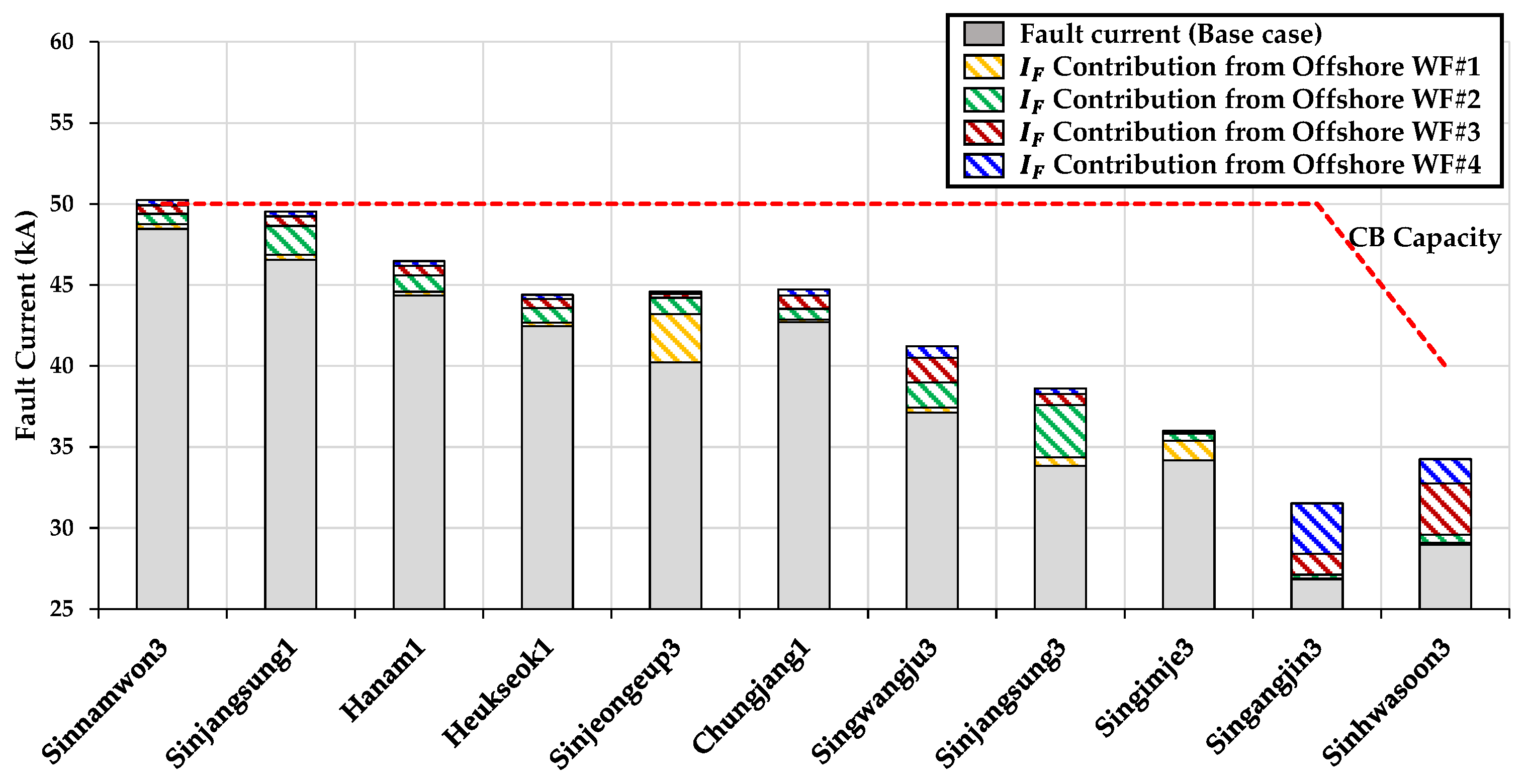
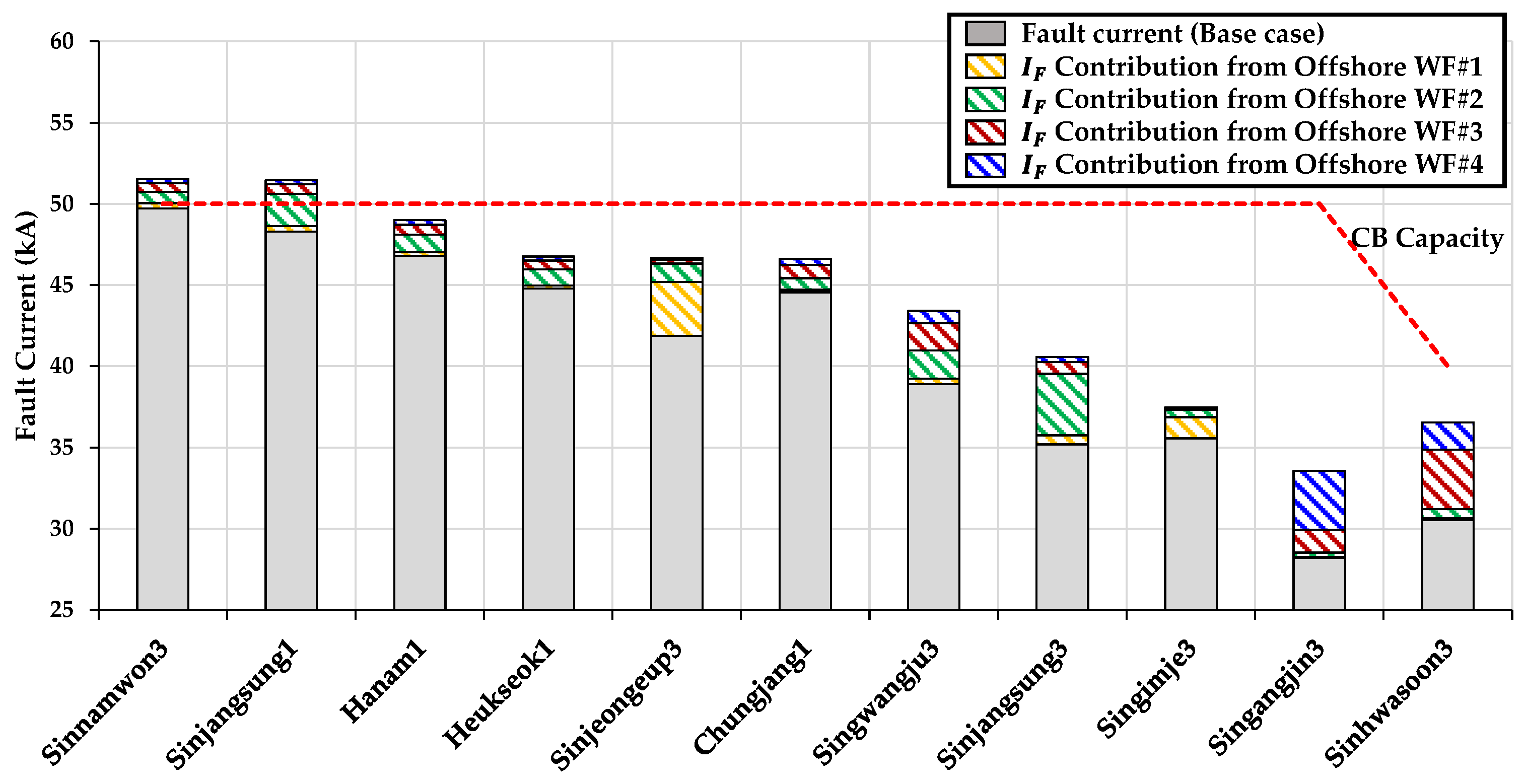
| Offshore Wind Farms | Point of Connection | Offshore Wind Generation | ||||
|---|---|---|---|---|---|---|
| Base Case | Case 1 | Case 2 | Case 3 | Case 4 | ||
| Wind Farm #1 (MW) | Sinjeongeup3 | 0 | 1680 | 1680 | 1680 | 1680 |
| Wind Farm #2 (MW) | Sinjangsung3 | 0 | 0 | 2450 | 2450 | 2450 |
| Wind Farm #3 (MW) | Sinhwasoon3 | 0 | 0 | 0 | 2100 | 2100 |
| Wind Farm #4 (MW) | Singangjin3 | 0 | 0 | 0 | 0 | 2940 |
| Total Offshore Wind Gen. (MW) | - | 1680 | 4130 | 6230 | 9170 | |
| Penetration Level of Offshore Wind (%) | - | 10.13 | 21.70 | 29.48 | 38.10 | |
| Type | Resistance (%/km) | Reactance (%/km) | Admittance (%/km) | Wind Farm #1 (km) | Wind Farm #2 (km) | Wind Farm #3 (km) | Wind Farm #4 (km) |
|---|---|---|---|---|---|---|---|
| XLPE 630 | 0.020540 | 0.005501 | 0.000013 | 30 | 30 | 30 | 30 |
| ACSR 480 | 0.002900 | 0.030800 | 0.524900 | 32 | 81 | 53 | 55 |
Publisher’s Note: MDPI stays neutral with regard to jurisdictional claims in published maps and institutional affiliations. |
© 2022 by the authors. Licensee MDPI, Basel, Switzerland. This article is an open access article distributed under the terms and conditions of the Creative Commons Attribution (CC BY) license (https://creativecommons.org/licenses/by/4.0/).
Share and Cite
Choi, N.; Kim, B.; Kim, D.; Park, B.; Kim, S.; Lee, B. Grid Connection Studies for Large-Scale Offshore Wind Farms Considering High Penetration of Regional Renewables. Sustainability 2022, 14, 1015. https://doi.org/10.3390/su14021015
Choi N, Kim B, Kim D, Park B, Kim S, Lee B. Grid Connection Studies for Large-Scale Offshore Wind Farms Considering High Penetration of Regional Renewables. Sustainability. 2022; 14(2):1015. https://doi.org/10.3390/su14021015
Chicago/Turabian StyleChoi, Namki, Beomju Kim, Dohyuk Kim, Bohyun Park, Sangsoo Kim, and Byongjun Lee. 2022. "Grid Connection Studies for Large-Scale Offshore Wind Farms Considering High Penetration of Regional Renewables" Sustainability 14, no. 2: 1015. https://doi.org/10.3390/su14021015
APA StyleChoi, N., Kim, B., Kim, D., Park, B., Kim, S., & Lee, B. (2022). Grid Connection Studies for Large-Scale Offshore Wind Farms Considering High Penetration of Regional Renewables. Sustainability, 14(2), 1015. https://doi.org/10.3390/su14021015






